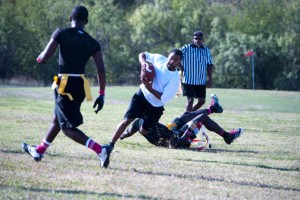
By Eric Poe/sports editor
Budgets, seemingly concrete, are quite fickle as they constantly need to be balanced, stretched or tightened at any time.
Budgets for TCC’s intramural programs are no different as each presents its own obstacles. Each campus is required to provide an athletic and recreational experience for the student body, yet the money sometimes just isn’t there to fulfill the intramural program’s ambitions.
“Our budget is $6,000,” South Campus intramural director and health and physical education department chair Mike Daniels said. “But in reality, I should have $20,000 in my budget. The intramural program is way underpaid.”
That is part of what Daniels faces trying to accomplish his goals when it comes to intramurals. Daniels has connections with coaches at other colleges that offer intercollegiate athletics. He wants to use the intramural program as a gateway for students with potential to play college sports and gain athletic scholarships after they leave TCC. He said the cost of the exposure to coaches, such as tournaments, prevents him from helping the students as much as he could.
“A lot of these kids are poor,” he said. “That’s why I fuss. I try and get them scholarships. But if you want to participate in a tournament, the cost is close to $1,000 with traveling costs and a stay in a hotel. And if we do a tournament, I have to feed them with my own money.”

Daniels is helping the students with life after TCC but is hamstrung by the limited amount of money allotted to him. He said a majority of the budget goes toward gym equipment, sports balls, uniforms and compensation for referees, which leaves little money for much else.
“I have to pay officials, and that’s $3,000 right there,” he said.
While Daniels struggles with his budget, NE Campus intramural coordinator Laura Bradford is content with her department’s annual allotment of $10,000.
“I’ve never been told I can’t do something because it’s not in the budget,” she said. “When we were taking students over to Putt-Putt and bowling for New Games, they clearly didn’t mind spending the intramural budget to do those things.”
Bradford said money went toward paying officials for certain sports, but a majority was spent on equipment for the newly formed Volleyball Club, including two standard nets and a referee ladder.
Interim HPE department chair Joy Thetford said the department gets by on the current budget and at the end of the year has enough leftover money to purchase expensive gym equipment like exercise bikes or free weights.
“One piece of equipment could be half of the budget,” she said. “But we usually don’t have any trouble spending it.”
NE intramurals haven’t been as prominent as on other campuses because of restricted facility space and congested usage, which helps to cut costs, Thetford said. That is why the department started New Games a few years ago — to offer students not as athletically motivated a chance to participate in events while forging relationships.
“Most of the money goes towards things that will make the college experience better,” she said.
Coming in between NE’s and South’s budgets is SE at $8,000 per year. Intramural coordinator Shahzad Nazir said the budget provides a measure of comfortability but keeps him from making necessary upgrades to the track.
“It develops cracks easily,” he said of the track. “We just refinished it less than two years ago, and it’s pretty bad. But you’re looking at seven, eight hundred dollars per piece for a 12-piece track set. So you’d need more money. It’s widely used by the community, and this is a community college, so it’d be nice to update it.”
Nazir’s ideal budget for the year is between $10,000-$12,000, which he said would allow him and his co-workers to run intramurals as efficiently as possible to fully benefit the campus and student body as it is the only program that encourages health and fitness.
Nazir stressed the need for an additional facility as there is a lack of space in the current one. He said he has one storage closet for three different departments, including intramurals, which has equipment piled on top of each other. There was also no room to put a rack of kettle bells in the weight room as it was already too crowded. Nazir said another facility would help improve intramurals as well as the faculty wellness program, but he is unsure where the money needed would come from.

“We do need a new facility, but I’m certainly not going to hold my breath on that one,” he said.
While SE needs a new gym, TR must do without one, which can present some difficulties for intramural coordinator Nick Giovannitti. He said they are making the most of what they have, in regards to the fitness center he is very proud of, but can be limited when it comes to scheduling sports.
Giovannitti has to rent a gym for any activity that needs one.
“We are limited with not having a full-size basketball court,” he said. “We have to pay for the use of the city’s rec centers and fields. This can put a damper on intramural leagues.”
Giovannitti does as much as he can helping form flag football and soccer teams for city leagues but heads an impossible task of hosting intramurals. He did praise other campuses for letting his campus teams participate in district events, but admitted it is difficult for the players.
“This can be hard on students who do not have adequate transportation to go to other campuses,” he said. “But we make lemons into lemonade.”
NW Campus intramurals is allocated $7,500 annually for its budget. Intramural coordinator Ryan Stewart declined to comment on the issue.
NW vice president of student development services Joe Rode gave insight into the question of differing campus intramural budgets. Intramurals falls under student development services.
“The budget for student development services is based upon student enrollment at each campus,” he said. “The vice presidents of student development services have some discretion on allocating funds to the many services and programs based upon need and participation by our students.”
Each campus is free to request additional money, which could provide the tonic for intramural departments struggling with its allocations, Rode said.
“The intramural departments are always welcome to request additional funding although they would need to provide supportive documentation for the request to increase funds,” he said.




























